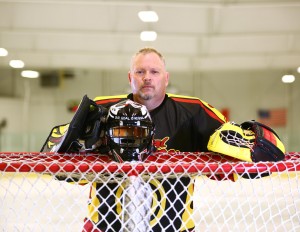A Little About Your Target Practice Podcast & Host
The “Target Practice” podcast promises to bring new ideas for goaltending practice to Hockey Talk Radio. Through weekly episodes, host Chris Dyson hopes to help team coaches, youth parents and goaltenders with the struggles of a very demanding position.
 Chris Dyson is passionate about hockey — specifically, goaltending. He believes enjoyment of the game for minor hockey-aged goalies is paramount, and that this can be achieved by developing better skills, which will inspire confidence through improved play.
Chris Dyson is passionate about hockey — specifically, goaltending. He believes enjoyment of the game for minor hockey-aged goalies is paramount, and that this can be achieved by developing better skills, which will inspire confidence through improved play.
Chris’ mission is to change the game of hockey from the grassroots up, by providing coaches with the tools and knowledge to properly help their goaltenders and keep the game fun for everyone.
For nearly 30 years, Chris has instructed students from over 18 countries, presenting Puckstoppers Goalie Schools in Europe, USA, and Canada. He has received accreditation for his professional coaching skills and personally instructed literally thousands of goaltenders, parents, and coaches.
As a Goalie Coach/Consultant, Chris has seen many disheartening situations, involving well-meaning coaches who lack knowledge and understanding of the very skills they are trying to teach to impressionable young goaltenders.
For many years, Chris and Puckstoppers (his goalie training company) have offered free seminars to minor hockey coaches in an effort to help educate and eliminate this situation.
Mr. Dyson is now on a personal mission to develop an awareness of proper goaltender training throughout minor hockey, with a goal of achieving 100% compliance for all coaches to learn and understand the Essential Core Goaltending Skills (ECGs).
Chris Dyson welcomes listener questions or comments below, and he promises to address them in future Target Practice hockey podcasts.


Chris, a hockey mom wrote me last night with a goaltending question, so — that being more your area of expertise, I thought I’d share it with you:
“My son is a 1st year atom goalie ..he drops really well , but we seem to have an issue of him standing up and coming out so shots are going over him …is there something to do to correct this or is it a habit from playing goalie on softer lower shots ..this is his 5 year
Lisa D”
Hi Lisa,
Great question and a very common problem I see even in at the pro level, goalies in general, tend to drop too soon.
The truth of the matter is, younger goalies have to be even more patient and understand when to drop and when to stand up and when to move out (take depth) or stay deeper. The pro’s are all 6’2″ and taller, where your average minor hockey goalie is much smaller. When a smaller goalie drops or stays too deep, a ton of scoring space opens up vs the bigger pro goaltenders. In addition the bigger and stronger the goalie is, the more lateral and recovery speed they will have.
Most younger goalies do not understand their spatial environment (the area they fill within the net) well enough to know how to properly react to shots outside their coverage area. They must also develop an understanding that there is superior ability to move from the stance (on their feet) and patience is something that definitely needs to continually be worked on at every practice.
The best way I have ever found to get the goalie to develop an understanding of depth and up vs down coverage, is through the old ‘rope drill.’ It is vital to have the goalie see and understand what we want them to do, before teaching it. We can talk about it all day, but ‘seeing is believing’ and they buy in a whole lot easier when they ‘get it.’
To execute the rope drill – Tie a rope to each corner of the net and extend the base of the rope out to the puck, this forms a triangle with the base of the triangle being the goal line and the top (point) of the triangle being the puck.
The rope can be moved around to many locations so the goalie can see where they need to play for maximum coverage. The visual is a powerful tool in helping them see how little scoring space is actually open when the goalie is playing out a little bit and also how minimal the movements need to be to close off the scoring lanes.
Once this visual is in their mind, it’s time to practice depth control and develop an understanding of their own speed and ability to close off the gap space if the play moves left or right. There are many drills that work this.
The problem is getting coaches to continually help the goaltender develop their depth control and continually work with them to develop good habits as well as an understanding of their spatial environment. Regardless of the drill, if this isn’t happening, the goaltender isn’t likely to improve.
I’ll address this issue in an upcoming program, please feel feel free to contact me with any additional questions or clarifications.
Thank you for the question.
Chris Dyson